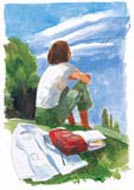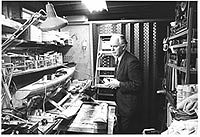Volume 20 Number 3
![]() Jump
to the Alumni section: Stanford MD
Jump
to the Alumni section: Stanford MD
Cover Story:
The new curriculum reflects
the school's overall efforts to better intertwine the basic and clinical
sciences
 |
|
A More Perfect Union
By Susan Ipaktchian
Today’s medical students face a fast-paced world of discovery in which some elements of their basic science training may be outdated by the time they complete their residencies while, simultaneously, the connection between bench and bedside is growing tighter. >> Read Story
The prostate puzzle
By Mitzi Baker
The only quantitative test for the presence of prostate cancer is riddled with inconsistency and, except in cases of extreme malignancy, gives no indication of the cancer’s severity. All current treatment options have significant shortcomings so the decision about which route to pursue can be daunting. >> Read Story
 |
More Stanford Medicine
Letter from the Dean
’Scope: A quick look at the
latest developments at Stanford University Medical Center
Mission translational: Tall order – Steroid
free transplant treatment a growing success
Prickled pink: Acupuncture gains
acceptance in U.S. children's hospitals
Brain flash: So that's how
nerve cells transmit information so quickly
Letter from SMAA President
Linda Hawes Clever, MD, '65
President, Stanford Medical Alumni Association
The start of an academic year is a quintessential transition, far more than the start of a calendar year somehow. >> Read Letter
 |
Alumni Memorial: Dedicated to Care
Belding Scribner, MD, dialysis pioneer and patient advocate
The death of one patient inspired Belding Scribner, MD, to invent a device that would save over a million people. Scribner, class of 1945, died in June at 82. >> Read Story
Medical School Recollection: The Little Class that Could
In 1963, a quirk of curriculum change created a tiny class with wide horizons. >> Read Story
Class Notes
Alumni dispatches beginning from the 1940s. >> Read Story

